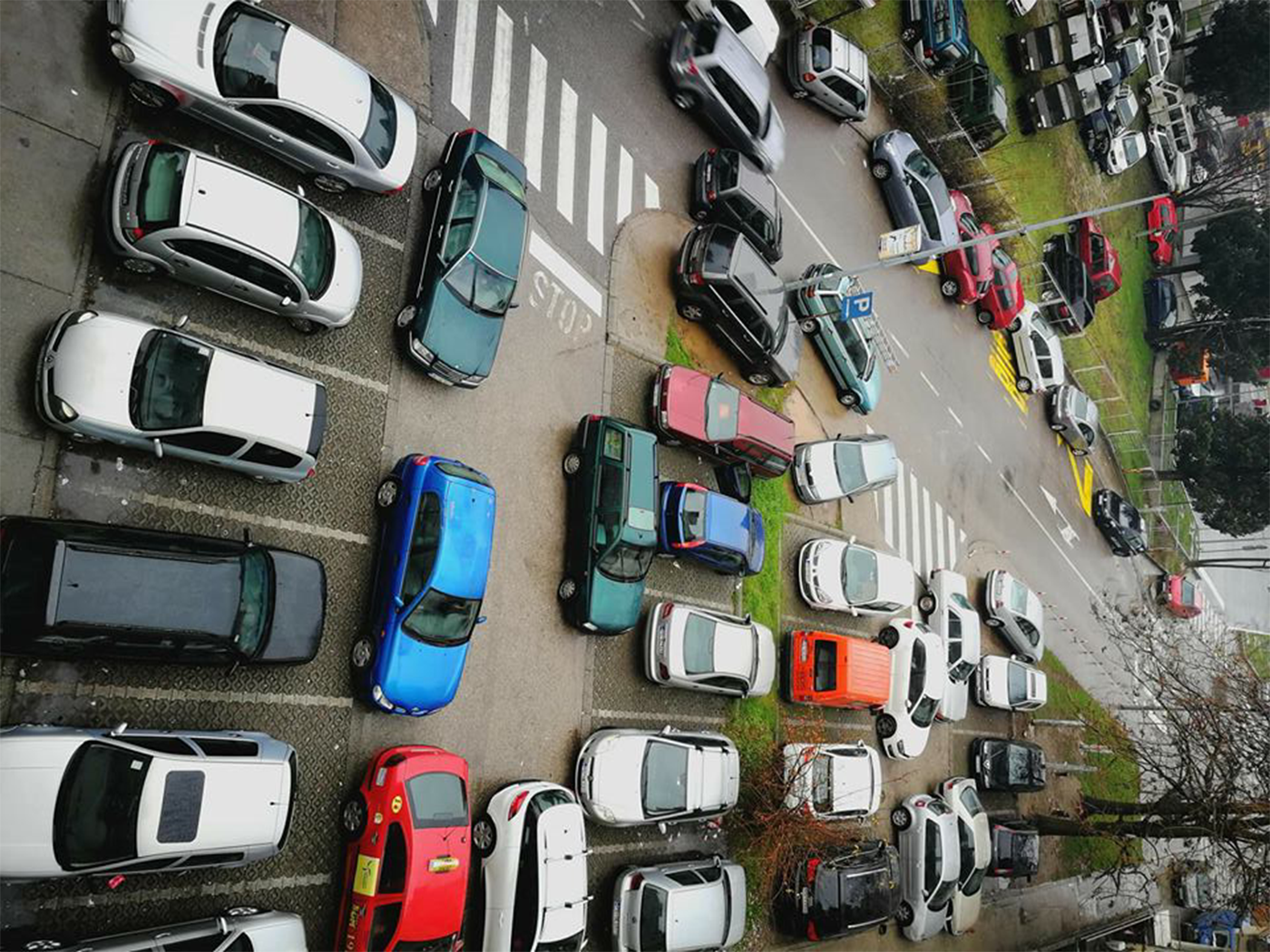
Podgorica, taken over by cars. Photo: Sonja Dragović
This January, professor Jan Gehl came to Podgorica to promote his book, “Cities for People”. The visit was quite a surprise: an announcement was made on a Friday that on the following Monday and Tuesday prof. Gehl would give a lecture and meet with officials. This instantly creating a wave of excitement among anyone who ever read anything about contemporary urban design and human-scale urban planning.
For me, this was a throwback to the time I spent as a 4Citizen, cycling around Copenhagen and studying Gehl’s “Life Between Buildings”. I was happy about the visit and curious about to professor’s impressions of Montenegro’s capital, a city I love – and love to criticize (as my former classmates and lecturers might remember). I had an opportunity to attend one of Gehl’s lectures during our semester in Vienna, and I’ve visited Gehl Architects during my time at University of Copenhagen, so I thought this would be a great opportunity to put some of my first-hand knowledge to good use and try to schedule an interview with prof. Gehl. I emailed him and introduced myself as a local activist for more sustainable urban transportation and against financialization in urban development. He responded right away, and we agreed to meet and do an interview during his visit.
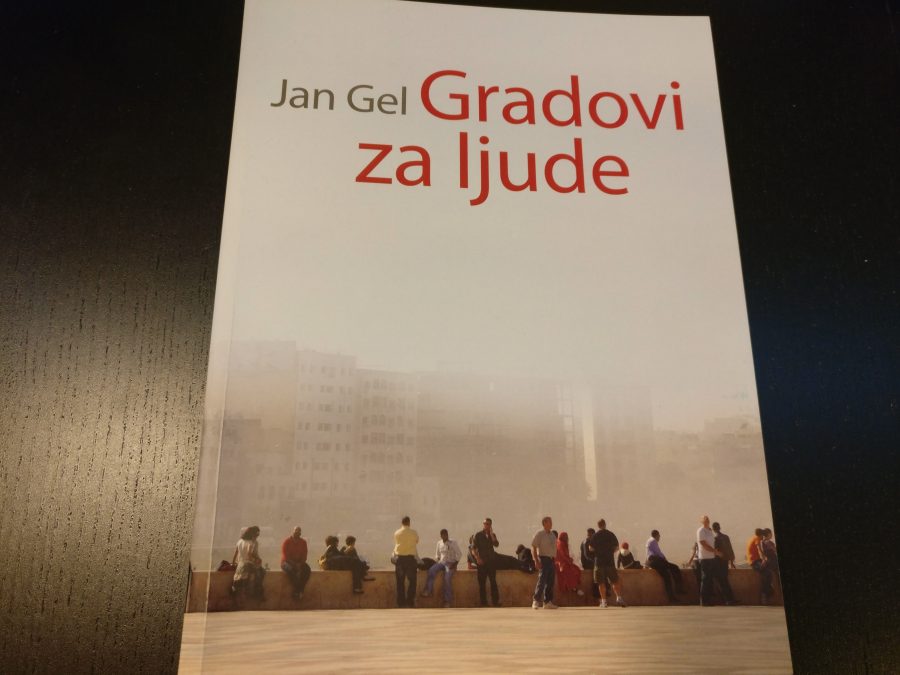
“Cities for People”, Serbian edition. Photo: Sonja Dragović
Gehl’s lecture was packed, with an audience consisting mostly – from what I could see – of students and professionals working in the field of architecture and urbanism; the NGOs concerned with urban development were largely absent. The lecture discussed the most important aspects of Gehl’s philosophy in urban design, underlying the steps to be taken in order to create a lively, livable, safe and sustainable city. City officials, along with the mayor who was also in attendance, nodded in agreement with the reasoning presented. After a one-hour lecture, we got on with book signing: everyone who attended could get a free copy of Gehl’s “Cities for People”, translated to Serbian. This was courtesy of the City of Podgorica, which, as I understood, was using this opportunity to invest in the education of its architects and urbanists.
Those with enough patience to wait could get their books signed by Gehl, who performed this ritual with patience and grace. In exchange for the book and professor’s lovely note, I presented him with a few photos of Podgorica I took over the last year. The pictures showed interesting examples of urban design, some of it good, most of it bad, and all of it definitely not found on the official postcards. We agreed to talk the next day, in the afternoon, during the “meet the press” sort of event at the hotel where Gehl was staying.
Podgorica: Green, Congested, Hopeful
The press conference, held in a hotel lounge, was organized in a bit of an unorthodox way: there were a handful of journalists present, each of whom would have a one-on-one conversation with Gehl while everyone else sat around and listened. As soon as I entered the room, I turned on my recording device and placed it in the center of the room, where it could pick up most of what was said. Now, after a day of walking around the city, the professor was ready to share his impressions:
“Podgorica is a pretty green city and, to my pleasure, the city skyline is not disturbed too much by extravagant skyscrapers. I have not seen too many brutalist buildings either, and they can be quite ugly. It is mostly a nice city, with a pleasant atmosphere. I think this is an important time in the city’s history. You have started working on promoting cycling – not too much, not enough, but something has been started. At the same time, there is an excessive use of cars, and the traffic congestion is critical. It is obvious that something needs to be done about it. I spent the whole day in the city and during all that time I saw only one public transportation bus. That’s really not impressive. There are ways to reduce this traffic pressure, there are a number of strategies, but the solution isn’t in building more roads. It will only make the problem worse.”
Journalists were curious to know how Montenegrins – often said to be lazy folks – could be persuaded to change their ways:
“In every city I have visited, everyone used to tell me on my first day – people here are different, we are lazier than others, or – we like our cars more than others. I heard that in Denmark as well 50 years ago. In New York everyone would say to me that my European ideas about cities for people would never work with them. Then they began closing the Broadway Bridge to motor vehicles and adapting Times Square to pedestrians. They are now making room for 50 squares where city life will be thriving. They started to behave humanely in New York and now can’t even remember who told them that it would not be possible. So please don’t say it is not feasible, as this city will realize in the next phase of its development that there is life after car dependency.”
Since the professor perceived Podgorica as a green city, and us locals know that it’s actually losing its greenery bit by bit, the question of trees surviving numerous new development projects also came up, to which Gehl had this to say:
“The best protection are the people, the citizens. If they really love their green city, they will make sure that the politicians do not stray off the right course: to make sure that the rules will protect the good things in the city from the interests of various developers. Engaged citizens and their active participation in improving the quality of living conditions – that’s the answer and the best way for the city to be preserved. I really think that Podgorica has true potential. We have a solid basis, plenty of possibilities – and I got the impression that there is a willingness to work on creating better living conditions in Podgorica, that the city authorities will be working more on that in the future. For this reason, they made a remarkable effort to invite me here, me and my associates – not only to have a stroll around the city, but also to talk about how we can cooperate and help in that process.”
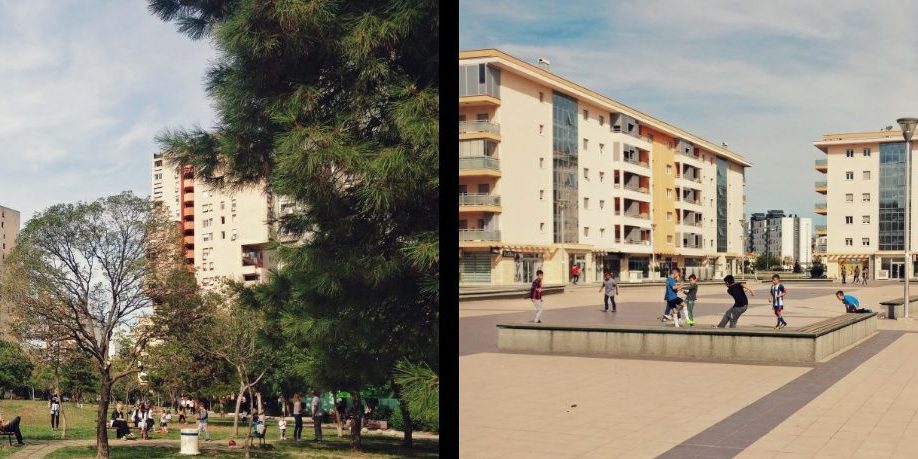
Old vs. new city blocks: green is fading away. Photo: Sonja Dragović
Gehl’s message to the Mayor of Podgorica, as he conveyed it to the journalists, was to proceed with optimism – and with caution:
“This is a very important moment in the city’s development, because if you’re not cautious, a part of those important green areas can easily disappear; then some high towers will be erected, then some investors will come and put up buildings where you don’t want them, and then the intensity of the traffic will increase, and more public space will turn into a parking lot. The situation could easily get worse very quickly. For this reason, at this moment it is important to have a strategy: what kind of city do you want Podgorica to become by 2030? Answer the question and then align the development policy with that strategy. It is very important to know where you want to be and what you want to achieve – it is much better to have a good plan than complete a couple of projects here and there. It is all about what you want to achieve: what kind of city would you like your children and grandchildren to grow up in? That’s the real question. And this is a good moment to answer it, as the situation might become much worse in five years, but also much better. It depends on what you do about it.”
Private Vs. Public interest
Once the journalists got all the answers they needed, prof. Gehl and I had a few minutes to discuss some questions in more detail. I started the conversation by quoting his book:
Sonja Dragovic: “It is widely believed that the lively city needs high building density and large concentrations of dwellings and workplaces. But what the lively city really needs is a combination of good inviting city space and a certain critical mass of people who want to use it.” I get your point, but dwellings and business premises are profitable. Their construction and sale bring a lot of money to investors. Parks and playgrounds and nicely designed public spaces are not so lucrative. They are good for citizens, but not as valuable to the real estate industry. I am asking you now, as an activist: how do we fight that? When we want to apply your principles for developing cities for people, we run into private interests that are not in agreement with those principles.
Jan Gehl: For my principles to be applied successfully – to concentrate urban activities in a small space, integrate them, stimulate pedestrian and bicycle traffic, open up buildings towards public space, increase the number of people using that space – we need to have clear urban planning rules. We surely need to know what the population density should be, but also must not let anyone build endlessly without providing a sufficient, clearly defined area of good quality public space.
SD: But that happens all the time in Podgorica. Over the past ten years only, we have had several projects involving the construction of residential buildings and blocks where plans used to show one thing – green areas, well-designed public spaces – while the result of the construction was something completely different. In most cases, only buildings and parking lots. Developers then just leave without any consequences, and continue to undertake construction work at another location, with no one holding them accountable.
JG: That is a problem that needs to be tackled by city planners and urban development inspectors. Respect for rules must be guaranteed.
SD: So, you are saying that the city has to be led by responsible people in order to avoid this?
JG: Well, yes, exactly. Actually, today I went to see that quarter with a lot of asphalt, with a huge concrete desert in the middle. That could have been made much better. Somebody could now take this book that we have just promoted in Podgorica, study the 12 principles I talk about in ‘Cities for People’ and re-design that place, right? There’s always the future.
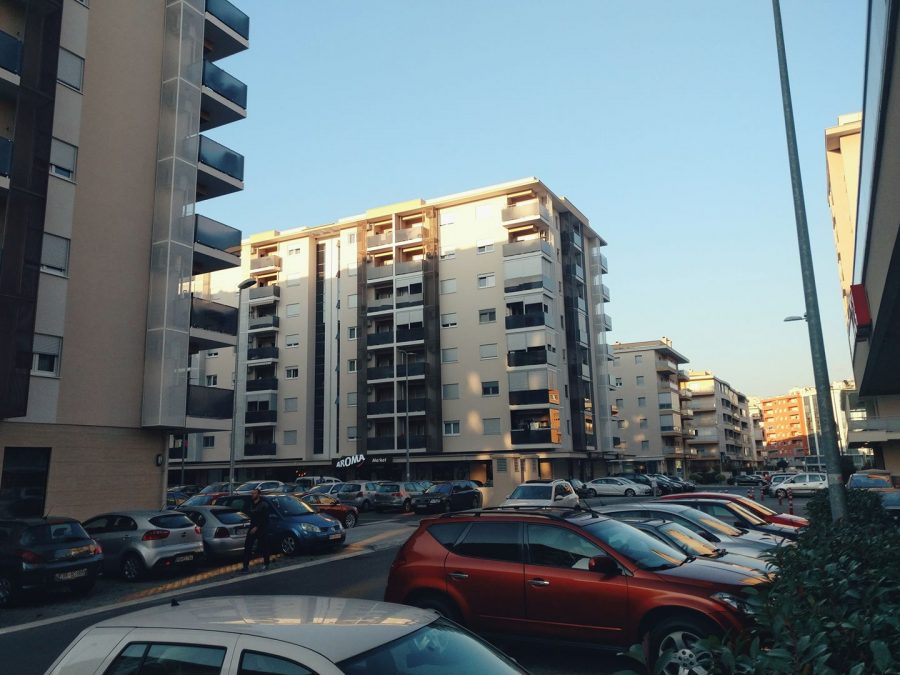
Concrete, asphalt: so called “City Quarter” in Podgorica. Photo: Sonja Dragović
SD: Yes, such urban design is something we are battling at the moment, something we are trying to correct.
JG: It is also important to address the population density. Many people say that we need to erect tall buildings to increase population density in cities. And I say to that – what’s wrong with Paris, or Barcelona? I even think that the population density in Barcelona is higher than in Manhattan. Generally speaking, high-rise towers and skyscrapers are a poor response to this challenge. If architects make an effort, if they really become interested in space, they can achieve the same population density with up to seven stories, and free us from silly towers.
SD: You came to Podgorica at the time of an important public debate, about a project involving the construction on the bank of Morača River, at a very attractive location in the city center…
JG: Yes, I saw the project today.
SD: Oh, so you have seen the project? And what did you think?
JG: Well, I had to tell the mayor that this project is not the best I’ve ever seen. It’s would not be a good strategy to do such an expensive and overdone project – like an omelet with too many spices! It would spoil the nature along that part of the riverbank and it’s really too expensive. So, I was not amused, and he was not amused to hear such an opinion. Also, I mentioned that it was not a good idea to spend so much money on such a project – the riverbank could be designed nicely for a third of that amount. Mind you, the city could really hire landscape architects, as it seems to me that the current solution was developed by transport engineers. There’s simply too much asphalt and concrete in that project. Landscape architects have “green fingers” and their contribution is always easy to see.
SD: I am really happy about your visit, as it will certainly stimulate new discussions on how to better promote and support urban cycling in Podgorica. You have seen that we have several bike lanes, but the city authorities are still not providing any other incentives. Do you think something will change?
JG: I think so. We also had a meeting with the Danish ambassador and I’ve been informed that in June this year there is going to be an event which will promote the application of Danish ‘green’ technologies and tools for sustainable urban planning. These ideas – and cycling among them – will surely receive more space and promotion. We can and should use examples and ideas from other countries and cities where the desired changes have already been made. Copenhagen was like Podgorica 40 years ago. Therefore, one should just make a plan and work hard to make it happen.
We parted amicably, with hopes that Gehl Architects will be coming back to Podgorica.
Riverbank Development Debate
I stayed up late that night to type up and translate the conversation so that it can be published online the next day. Especially valuable, as I saw it, was the information regarding Gehl’s opinion about the project being developed on the riverbank, in the city center. Gehl’s critique was coming right on time as the public debate on the riverbank development project was opened a few days before, and it was just starting to heat up, with many architects and urbanists from the academic and independent scene expressing their concern and disapproval.
The controversial plan called “Urbanistic Project Morača Military Barracks” was funded by a private developer, and it proposed taking down the existing cypress park along with military barracks (i.e. some of the oldest buildings in Podgorica downtown) and building around 150.000 m2 of housing and business space in its place, along with underground garages that would make it impossible to re-grow the park. While local and national government institutions went on with the process for the adoption and implementation of this plan, numerous actors from the independent scene (NGOs, journalists, activists) and some political parties were trying to get public attention and support in trying to stop it. In the middle of this public conversation, Gehl came to Podgorica, and I could only hope that I would get an opportunity to tell him briefly about this plan and hear his – hopefully, disapproving – opinion. After completing the interview, I was happy that I got not a vague dismissal of some unclear development proposal, but quite detailed critique of a project that has been, apparently, shown to the professor during his visit. If he didn’t like it, the official institutions can’t say that the rest of us are wrong for criticizing it.
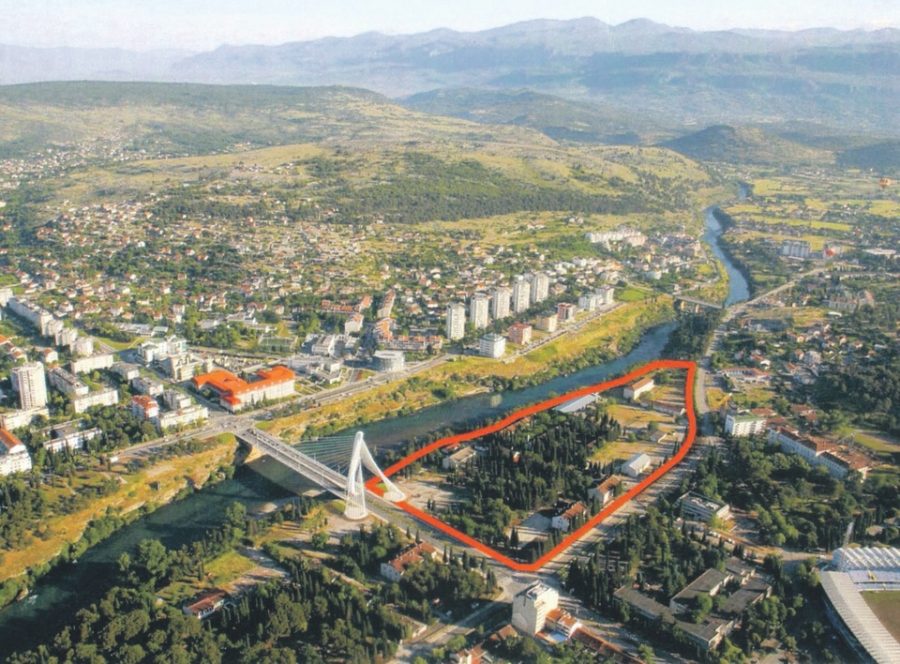
The area proposed for redevelopment by the “Morača Military Barracks” project. Photo: Luka Zeković
The interview was widely read and well received, with Gehl’s points on the importance of civic engagement, strict urban planning rules, sustainable transportation and clear urban development vision recognized as obviously necessary to follow if we want to develop a better city. His critique on riverbank development was also welcomed by civic organizations and activists, and seen as potentially useful in organizing resistance against this proposal.
The next day, the newspaper that published the interview informed me they had received a letter from the Belgrade company who organized Gehl’s visit to Podgorica, in which they denied that the professor commented on the “Morača Military Barracks” project. According to the statement, Gehl was shown a different project, concerning the development of a sports and recreation area on a different part of the riverbank. Hence, he knew nothing about the project that I assumed he was telling me about during our conversation, while I knew nothing about this other project, since it has not been made public yet. In the next few hours, more letters arrived and were promptly published: one from the Local Government PR office, accusing me of lying and knowingly misinterpreting Gehl’s words for political gain, another one from Gehl himself, expressing regret that his words were misinterpreted. I responded by admitting it is possible we were talking about different projects and didn’t know it at the time, and asking for this honest mistake not to be interpreted as deliberately misleading. However, the public attacks on me continued over the next couple of days.
Who Plans for Whom?
What happened during and after professor Gehl’s visit says a lot about the root causes of problems with urban planning in Podgorica: there’s a lack of critical debate, and an unwillingness to prioritize goals of livability and sustainability over short-term monetary gains.
Prof. Gehl, in his own words, was invited to Podgorica to help forge a path towards a city that is better for all its people. His remarks are instructional: it is important to have clear and strict urban planning laws, progressive vision, good landscape architects, and active, engaged citizens. This is excellent advice, and it is encouraging to think that city officials might be ready to listen. Their actions, however, don’t yet correspond. For example, trying to silence and defuse the public outrage over the ill-conceived riverbank development project by resorting to rude verbal attacks does not bode well for the future.
It is essential to honestly answer one question: who should benefit the most from our urban planning practices? If the answer is “current and future citizens of Podgorica, regardless of age, socio-economic status or political affiliation”, then the process of urban development needs to become more inclusive, collaborative, critical, more thoroughly examined and debated than it currently is. That’s not easy, but it’s the only way to govern and plan our city responsibly – and it’s completely in line with “Cities for people” principles outlined by prof. Gehl.
If the answer to this question is anything else, and especially if all the available evidence points to the answer being “private interests of powerful individuals”, then citizens must resist and demand change. Lack of political will and strength to put the public interest first can and should be confronted. As Gehl puts it: the best protection for the city are the citizens. I would add: people who speak up, take action and understand that the future of their city is their future, too.


